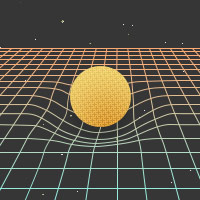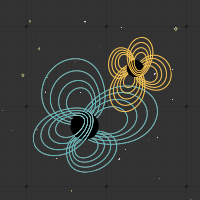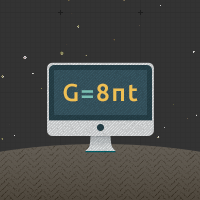The Moving Point of View
Where “now” depends on how fast you're moving
Einstein's revolutionary solution to the problems we've just seen starts out with a very simple “thought experiment.” If we follow through with these thoughts faithfully, we are led to some startling conclusions. Among them, we find that space and time have to be brought together into a single, unified concept.
To see why, it is easiest to start out simple. We imagine that it is only possible to move along one line, so that space is sort of one-dimensional. Suppose that we have an astronaut floating in this one-dimensional space, with a mirror off to her right. She sends out a flash of light, which bounces off the mirror, and comes back to her. If we trace out this movement on a chart, we get a graph of everything's position in time. Press “Play 1” on the animation below. Note that we have chosen to run the chart so that the light ray moves at an angle of 45 degrees. This angle indicates the speed of that pulse of light.
That was simple enough, so now let's add another astronaut who moves to the right. We can make another chart of this. (Press “Play 2” below.) The chart is almost the same as the first one, with an extra line for the second astronaut. Note that it looks like he passes the first astronaut at the same moment as the light bounces off the mirror. We can see this in the chart by noting that the point where the red and blue lines cross is at the same level as the point where the yellow line turns back.
Of course, we remember that the two astronauts just have different viewpoints, which should be treated equally. That means that we should make another chart for the second astronaut. Just as the first astronaut was floating still in one place from her point of view, the second is floating in one place from his point of view. Just as he was moving to the right from her viewpoint, she (and the mirror) are moving to the left from his viewpoint. Also, the light must be going at the same speed, and thus should make the same angle of 45 degrees on our chart. We get one last chart. Press “Play 3” above.
This is the correct chart, but notice something bizarre. From the second astronaut's perspective, the two astronauts don't pass at the same moment that the light bounces off the mirror! This unexpected result, called the failure of simultaneity, comes directly from the two facts that Einstein chose as his basic assumptions:
- different observers moving relative to each other should be treated equally
- everyone measures the same speed of light
The failure of simultaneity is really an astounding idea, and scientists now believe that it describes how Nature actually operates. Its effect is stronger when two observers are moving relative to each other at nearly the speed of light. Since humans don't usually move that fast compared to any other humans, we don't notice this very often. It demonstrates an interesting idea, however. Two points separated only in space from one observer's viewpoint are separated in space and time from the other's viewpoint. The notion of here seems to get mixed in with the notion of now. That is, the notion of space gets mixed in with the notion of time, in a way that depends on the observer, and how fast he or she is moving. Einstein decided that it was appropriate to make these two concepts into one: space and time would become spacetime.
For the charts above, the whole gray area represents spacetime. To make sense of it, we — its observers — just take slices out of this spacetime and split it up into space and time separately. The observer that is motionless in each chart takes any horizontal line, and says that every point on that line is at the same time. For example, in the chart from the first astronaut's point of view, the line connecting the point where the two astronauts pass and the point where the light bounces off the mirror is a flat line, so every event located along that line would be simultaneous, from her point of view.
With a little thought, it's not hard to see that the second astronaut's time slices on this diagram must be along slanted lines; in the chart from his point of view, we saw that the passing came before the bouncing. In a similar way, we see that the second astronaut's time slices in the third chart are flat lines, while the slices of the first astronaut are slanted. It may seem to go against common sense, but this is how the physical world actually operates. Again, Nature won't care which slices a particular observe takes, so all laws that correctly describe Nature should take this “spacetime” viewpoint.
We can also include a second dimension of space in our spacetime. When the observers split up this spacetime into space and time, they take slices that aren't lines, but two-dimensional sheets representing space. We can go further, and include all three dimensions of space in our spacetime. Then, the observers take infinite three-dimensional blocks for their slices. In each case, the slice — whether a line, a sheet, or a block — depends on the observer, and how fast he or she is moving.
This is the essence of the Special Relativity. Though it was a great achievement for Einstein — explaining the curious result of the Michelson-Morley experiment — he didn't stop there. He decided to allow his slices to be bent and warped in funny ways. By doing this, Einstein introduced the world to the General Relativity.






